NCERT Class 6 Science Chapter 5 Class 6 Science Body Movement Long Questions And Answers
Question 1. Plants do not move from one place to another. Do they show any other kind of movement? What types of movements are shown by plants?
Answer: Plants do not move from one place to another, but they show other kinds of movements. For example, the movement of sunflowers toward the Sun, the movement of roots toward the water, and the wrinkling of leaves of touch-me-not plants when touched, etc.
Question 2. Fill in the table given below to explain how animals move from place to place.

Answer: The table given below explains the movement of animals from place to place

Question 3. Why are there so many differences In the way that animals move from place to place?
Answer: There are so many differences in the way that animals move from place to place because of the differences in their body structure and also the different types of environments in which they live.
Read and Learn More Class 6 Science Question And Answers
Question 4. Fill In the table given below showing different types of movement in our body.
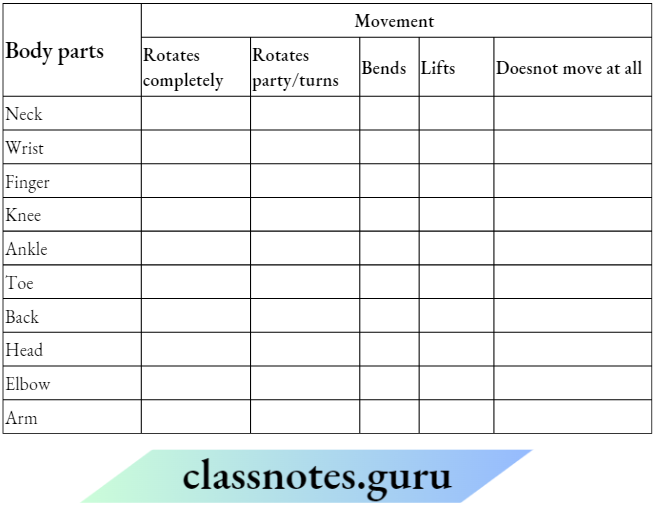
Answer:
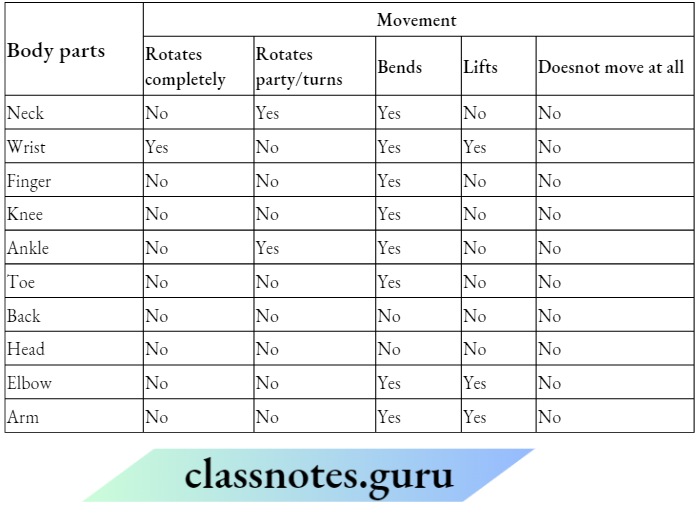
Question 5. Why is it that we can move a few parts of our body easily in various directions and some only in one direction? Why are we unable to move some parts at
Answer: We can move a few parts ofour body easily in various directions and some only in one direction. Some parts are fixed, i.e. they do not move at all. This is because the movement depends upon the type of joint that joins two or more bones together.
For example, the body parts having ball and socket joints move in all directions, while the body parts having hinge joints move only in one direction. The body parts having fixed joints are unable to move at all.
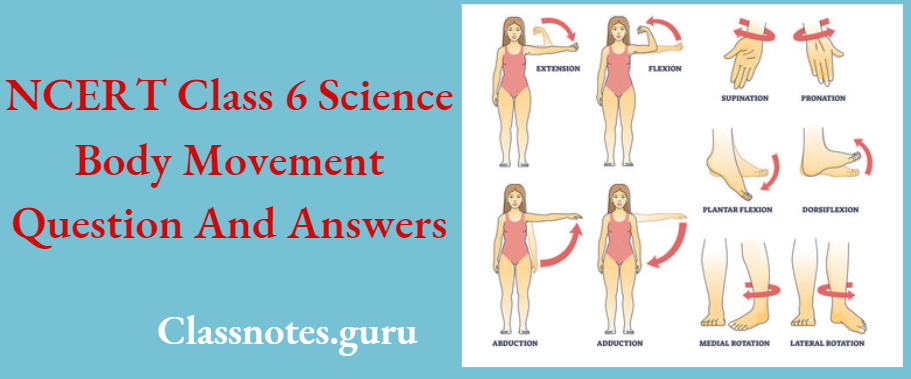
Question 6. How do we bend our elbows?
Answer: The elbow is not one long bone from the upper arm to our wrist. It consists of different bones joined together at the elbow. The joint present at the elbow is the hinge joint that helps in bending
Question 7. How many bones does the middle finger have?
Answer: The middle finger has three bones.
Question 8. Are muscles and bones always required for mo Pages
Answer: Yes, muscles and bones are always required for movement.
Question 9. Do all animals have bones?
Answer: No, all animals do not have bones. For example, earthworms.
Question 10. How does an earthworm fix parts of its body to the ground?
Answer: Earthworms possess a large number of tiny projections called bristles. These bristles are connected with muscles. They help to get a grip on the soil and thereby, help the earthworm in fixing parts of its body to the ground.
Question 11. Is the movement of a snail slow or fast as compared to an earthworm?
Answer: The movement snail is slow as compared to an earthworm.
Question 12. Why do different animals have the body parts that they do have and how do these body parts help animals to move the way they do?
Answer: Use of the differences in the way of their movement. For example, a snail has a thick muscular foot for movement Cockroach has three pairs of legs that help in walking.
Question 13. What are the differences in body parts between different animals used for movement?
Answer: Animals of different kinds of body structures move in different ways using different body parts such as legs, wings, fins, tails, etc. These help them to walk, jump, fly, swim, run, etc.
Question 14. Why are there two legs for humans and four for cows and buffaloes?
Answer: Technically, humans do have four legs however when we evolved, the muscles in our legs grew stronger and longer, allowing us to stand upright. However, cows did not evolve with time and they still need four legs to balance themselves and around.
Question 15. Why is the bending of our legs different from that of our arms?
Answer: The bending ofour legs is different from that ofour arms because of the differences in their position and role in our body. Although they both are hinge joints, they bend in opposite directions.
Question 16. Distinguish between the following
- Movable joint and fixed joint
- Ball and socket joint and hinge joint
Answer: Differences between movable joints and fixed joints are as follows

Differences between Ball and socket joint and hinge joint are as follows-
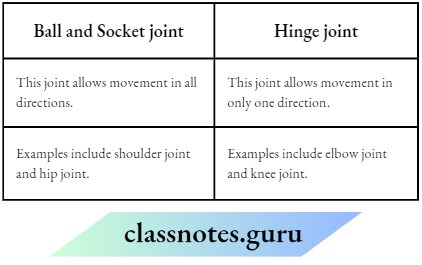
Question 17. Draw a diagram to show the Joint In the hand and answer the following questions.
- Can you bend your finger at every joint?
- How many bones are there in a human skull?
- Is your wrist flexible?
- What would happen if your hand had only one bone?
Answer:
- We can bend our fingers at every joint.
- The human skull has 22 bones
- Yes, our wrist is flexible.
- If our hand had only one bone, then we would not be able to bend our fingers and other parts of our hand
Question 18. How is the skeleton of a bird well-suited for flying?
Answer: The skeleton of a bird is well-suited for flying because
- Bones are hollow and light in weight.
- Bones of hindlimbs are used for walking and perching.
- The bones of the forelimbs are modified as wings.
- Shoulder bones are strong and helpful in flying.
- Breast bones hold flight muscles and are used to move the wings up and down for flying.
Question 19. In the figure given below, there are two snakes of the same size, slithering on sand. Can you identify which of them would move faster and why?
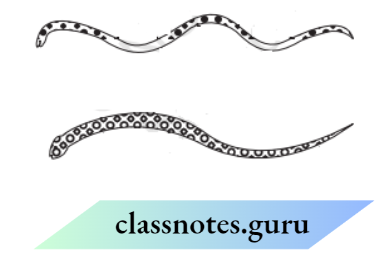
Answer:
A snake forms loops in its body while slithering. Each loop of the snake gives it a forward push by pressing against the ground.
The snake with a larger number of loops will move much faster than the snake with a lesser number of loops. Thus, snake A will move faster than snake B as we can see that loops in snake A are more than in snake B.
Question 20. Joints are the locations in the human body where two bones are connected. The picture shows three types of joints. The arrows show the movement of the bones in each Joint

- In which joint can the pair of bones move in all directions?
- Which two joints shown in the picture are of the same type?
- Mention the name of that type of Joint.
- Some bone Joints are fixed and the bones at these joints cannot move. Which of these are fixed Joints?
- Joints in the toe
- Joints in the neck
- Joints in the wrist
- Joints in the skull.
Answer: The pair of bones can move in all directions in joint 3 as it is a ball and socket joint.
Joint 1 and joint 2, shown in the picture are the two joints that are of the same type. These are hinge joints.
Joints in the skull
21.

- In which position are the biceps most contracted?
- Which of these statements is true?
- The largest muscles of the human body are located in the arms
- The bending of the anus is controlled by muscle
- The muscles located in the arm have a feed shape
- Bending of arms involves the contraction and relaxation of a pair of muscles
Answer: The bending of arms involves the contraction and relaxation of a pair of muscles.
NCERT Class 6 Science Chapter 5 Body Movement Short Question And Answers
Question 1. Given below is a list of different types of movements in animals: Running, jumping, walking, slithering, crawling, flying swimming creeping. Write the types of movements seen in each animal.
- Duck
- Horse
- Kangaroo
- Snail
- Snake
- Fish
- Human being
- Cockroach
Answer: The types of movements seen in each animal are-
- Duck — Flying, walking, and swimming
- Horse — Running, jumping, and walking
- Kangaroo — Jumping
- Snail — Creeping
- Snake — Slithering
- Fish — Swimming
- Human being — Walking and running
- Cockroach — Walking and flying
Question 2. Which type of movement would have been possible if
- Our elbow had a fixed Joint.
- We were to have a ball and socket joint between our neck and head
Answer: If our elbow had a fixed joint, we would not be able to bend or fold our arms. A fixed joint does not allow any movement.
If we were to have a ball and socket joint between our neck and head, we would be able to rotate our head 360°. A ball and socket joint allows movement in all directions.
Question 3. Bones are hard structures and cannot be bent, but we can still bend our elbows, knees, etc. How is this possible?
Answer: The elbow and knee are not made up of a single bone rather they are made up of two or more bones that are joined to each other at a joint, i.e. hinge joint. This joint along with the muscles helps us to bend the elbow and knee.
Question 4. Study the classification chart given below
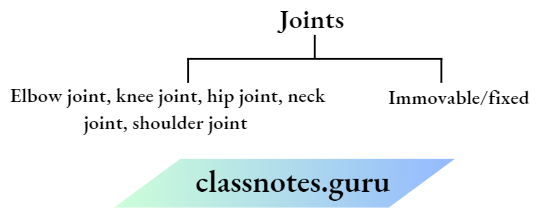
What are A and B? Why?
Answer: A is the movable joint, which is further classified into
- Ball and socket joint-e.g. hip joint and shoulder joint.
- Pivotal joint – example between neck joint and head joint.
- Hinge joint – Example elbow joint and knee joint.
- B is the immovable or fixed joint. It is located within the skull. The upper jaw is fixed to the skull bones with the help of fixed joints.
Question 5. Write the type of joint which is used for each of the following movements
- A cricket bowler bowls the ball.
- A girl moves her head in the right and left direction.
- A person lifts weights to build up his biceps.
Answer:
- Ball and socket joint
- Pivotal joint
- Hinge joint
Question 6. Mention the number of bones present In the human skeletal system. Give its functions.
Answer: The human skeletal system is made up of 206 bones.
The functions of the skeletal system are
- To provide shape and support to the body.
- To protect internal organs.
- To make movements possible
Question 7. There are 12 pairs of curved bones called the Xln chest region. One end of bone X is joined to backbone and the other end is joined to bone Tin the front to form a box-like structure Z. This strong, box-like structure protects the delicate organs P, Q, and Rour body.
- What are (a) X, (b), and (c) Z?
- Name the organ
- P
- Q
- R
Answer:
- Ribs (X)
- Breast bone (Y)
- Ribcage (Z)
- Heart (P)
- Lungs
- Liver (R)
Question 8. State the consequence if the backbone had only one long bone instead of many vertebrae.
Answer: Our backbone is comprised of 33 small bones called vertebrae. These are joined together with soft tissue in the form of cartilage discs. This arrangement makes these bony structures have some limited movements of the body.
If there is only one long bone instead of many in the backbone, the organism will not be able to avail the limited movements that are necessary for the organism for its survival.
Question 9. Write two ways by which we may know the shape of the human skeleton.
Answer: The two ways are given below
- We can determine the shape of the human skeleton by feeling the bones ofour body.
- We can also take X-ray images skeleton by using X-ray imaging
Question 10. Write the differences between bone and cartilage.
Answer: The differences between bone and cartilage are as follows
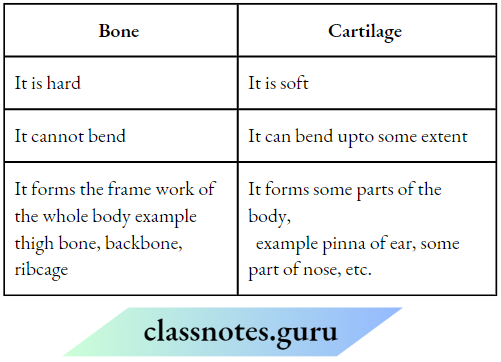
Question 11. The skeleton is made up of bones, but it has some cartilage too. Do you agree?
Answer: Yes, cartilages are the additional parts of the skeleton that are not as hard as the bones and which can bent. So, we can say that though most of the skeleton is made up of bones, it has some cartilage too.
Question 12. Provide one-word answers to the statements given below.
- Joint which allows movement In all directions
- The hard structure that forms the skeleton
- Part of the body with a fixed joint.
- Help in the movement of the body through contraction and relaxation
- Bones that Join with the chest bone at one end and to the backbone at the other end
- Framework of bones which gives shape to our body
- Bones which enclose the organs of our body that lie below the abdomen our
- A joint where our neck joins the head
- Part of the skeleton that forms the earlobe
Answer:
- Ball and socket joint
- Bones
- Upper jaw with the skull
- Muscles
- Rib
- Skeleton
- Pelvic bones
- Pivotal joint
- Cartilage
Question 13. We need two muscles together to move a bone. Why?
Answer: A muscle can only pull, it cannot push. Thus, two muscles are required to work together to move a bone. When one muscle contracts, the bone is pulled. When another muscle of the pair pulls, it brings the bone back to its original position.
Question 14. Bhoojho fell off a tree and hurt his ankle. On examination, the doctor confirmed that the ankle was fractured. How was it detected?
Answer: The doctor must have observed swelling around his ankle and must have taken an X-ray of his ankle. X-ray images confirm any type of injury or fractures in the bones.
Question 15. The gait differs in different animals. Explain.
Answer: Different animals use different organs to move from one place to another. So, the manner of movement, i.e. the gait also differs in different animals.
Question 16. Earthworms are known as farmer’s friends why?
Answer: An earthworm is called a farmer’s friend as it eats its way through the soil thereby, loosening the soil. Also, the earthworm’s body excretes the undigested materials that increase the fertility of the soil.
Question 17. Can you imagine how an earthworm fixes parts of its body to the ground?
Answer: Under the earthworm’s body, it has a large number of tiny bristles projecting out. The bristles are connected with muscles and help to get a good grip on the ground.
Question 18. The skeleton of a cockroach is called an exoskeleton. Do you agree? Explain.
Answer: The body of a cockroach is covered with a hard outer protective covering called an exoskeleton. The skeleton of a cockroach is called the exoskeleton because it is present outside the body.
Question 19. The body of the fish is similar to that of the boat. Explain, how fish move in the water.
Answer: The streamlined shape of fish helps it to move in the water. The skeleton and muscles present on the front side of fish move on one side, while the tail muscles move the body on the other side. This makes a jerk and pushes the body forward. In this way, fish moves in water.
Question 20. Name the organisms that show these movements.
- A thick muscular foot of the organism helps in dragging the shell.
- The organism curves its body into various loops.
- Their loops push the body forward.
Answer:
- Snail
- Snake
Question 22. The table shows how different animals move
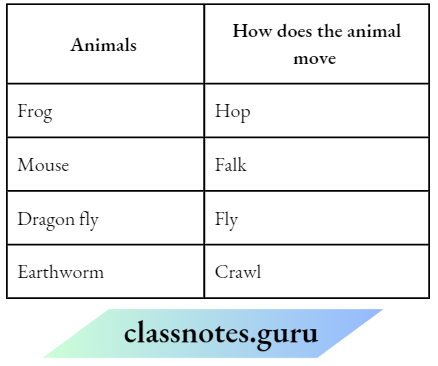
Which animal uses all of its body parts to move?
- Frog
- Mouse
- Dragon
- Earthworm
Answer: 4. Earthworm
What helps a frog hop?
- Strong leg muscles
- Short body length
- Two pairs of legs
- Absence of a tail
Answer: 1. Strong leg muscles
Question 2. Rishi was playing in a garden. It was the rainy season. He observed an organism moving on the soil Based on his observation of the manner of movement, which organism is likely to be seen?
- Ant
- Cockroach
- Earthworm
- Snake
Answer: 3. Earthworm.
NCERT Class 6 Science Chapter 5 Body Movement Assertion-Reason Questions
The following questions consist of two statements. Assertion (A) and Reason (R). Answer these questions by selecting the appropriate option given below.
- Both A and R are true and R is the correct explanation of A
- Both A and R are true, but R is not the correct explanation of A
- A is true, but R is false
- A is false, but R is true
Assertion (A) We can bend our body parts only at the joints.
Reason (R) Joints are those points where two or more bones are joined together.
Assertion (A) Pivot joint allows movement in all directions.
Reason (R) In a pivot joint, the rounded surface of one bone fits into a ring formed by the other bone.
Assertion (A) The bodies of the birds are well suited for flying.
Reason (R) The Presence of hollow bones makes the bones of birds very light
Answers
- Both A and R are true and R is the correct explanation of A.
- A is false, but R is true. A can be corrected as the Pivot joint allows only rotational movement.
- Both A and R are true and R is the correct explanation of A.
2. Direction The following questions consist of two statements. Assertion (A) and Reason (R). Answer these questions by selecting the appropriate option given below.
- Both A and R are true and R Is the correct explanation of A
- Both A and R are true, but R is not the correct explanation of A
- A is true, but R is false
- A is false, but R is true
1. Assertion (A) An earthworm does not have bones. Reason (R) The body of an earthworm is made up of many rings, joined end to end.
Answer: 1. Both A and R are true and R Is the correct explanation of A
2. Assertion (A) Cockroaches can walk, climb and fly upto a short distance.
Reason (R) They have three pairs of jointed legs and two pairs of wings attached to the breast region which help them to walk and fly, respectively.
Answer: 1. Both A and R are true and R Is the correct explanation of A.
NCERT Class 6 Science Chapter 5 Body Movement Very Short Answer Type Questions
Question 1. Name the parts of our body responsible for the movements.
Answer: Bone and muscles ofour body are responsible for the movements.
Question 2. If there are no joints, then will it be possible to move? Explain.
Answer: No, movement in the body of an animal is possible in the presence of joints only.
Question 3. Can we bend our bodies at every part?
Answer: No, we can bend our body at every part, but only at joints.
Question 4. The arm rotates at a specific part of the body. Name the part at which the arms rotate.
Answer: Shoulders are that part of the body (or skeleton) to which our arms are attached and at which the arms rotate.
Question 5. Name the type of joints of your hand that help you
Answer: The hinge joint ofour hand helps us to grasp a badminton racquet.
Question 6. What do you mean by skeleton?
Answer: The bones and cartilage in our body form a framework that supports the whole body and gives a shape to it. This framework is called the skeleton.
Question 7. Name three components of the skeletal system.
Answer: A skeleton is made up of many bones, joints, and cartilage.
Question 8. Name the type of joints present mainly in the skull.
Answer: The skull bones are joined together by fixed joints.
Question 9. The hard and strong skull protects a delicate organ of our body. Name that organ.
Answer: The hard and strong skull protects a delicate organ of our body called the brain.
Question 10. Name the organs that are protected by the ribcage
Answer: The heart and lungs are protected by the ribcage.
Question 11. What would have happened if our backbone was
Answer: If our backbone was made up of one single bone, then we would not have been able to bend our body (from the waist).
Question 12. If an earthworm does not have bones or legs, then how does it move?
Answer: An earthworm does not have bones or legs. It has muscles which help it to lengthen and shorten the body to move.
Question 13. Comparing an earthworm and a snail, explain which of the two moves faster.
Answer: Earthworm moves faster than snails.
Question 14. Cockroaches can fly as well as walk. What helps the cockroach to walk?
Answer: Three pairs of legs help cockroaches to walk.
Question 15. Write any two adaptations of birds for flying in the air.
Answer: The following adaptations are seen in the body of birds.
- Bones are hollow making the body lightweight for flying.
- Forelimbs are modified into wings.
Question 16. Name three animals having streamlined bodies.
Answer: Fish, birds, and snakes have streamlined bodies.
Question 17. Some animals like fishes, birds, and snakes move due to their streamlined bodies. What do you mean by streamlined?
Answer: If the body tapers at both ends, then such a body shape is said to be streamlined.
Question 18. What is a ball and socket joint?
Answer: A joint in which the rounded end of one bone fits into the hollow space of another bone is called a ball and socket joint It allows movements in all directions. Joints between the upper arm and shoulder, thigh and hip are examples of ball and socket joints.
Question 19. Which of the skull bones are movable?
Answer: In the skull, only the lower jaw is movable. All the other bones of the skull are immovable.
Question 20. Why can our elbow not move backward?
Answer: Our elbow cannot move backward because the elbow has a hinge joint that allows movement in only one direction.
NCERT Class 6 Science Chapter 5 Body Movement Fill In The Blanks
1. Unscramble the jumbled words and write them in the blank spaces provided
- Neosb-Bones
- Tnemevom-Movement
- Iontcaront-Contraction
- Isecsum-Muscles
- Arctigeal-Cartilage
- Ephas-Shape
- Inerlant sangro-Internal organs
- laxaeriont-Relaxation.
2. Read the following paragraph and fill in the blanks using the word you unscrambled.
Bones and cartilage from the skeleton of the human body. they provide the framework, give shape to the body, and help in movement. They protect the internal organs. The bones are moved by alternate contraction and relaxation of two sets of muscles attached to them.
6. Contraction of muscles pulls the bone during movement.
7. The shoulder joint is an example of a ball and socket joint.
8. Joints of the bones help in the Movement of the body.
9. A combination of bones and cartilage forms the Skeleton of the body.
10. The bones at the elbow are joined by a Hinge joint.
11. The contraction of the Muscle pulls the bones during movement
NCERT Class 6 Science Chapter 5 Body Movement True Or False
1. All joints in our body are similar. False, joints are of mainly two types, i.e. fixed and
movable.
2. The upper jaw is movable. False, the lower jaw bone is the only movable bone in
the skull.
3. The ribcage protects vital internal organs like the heart, lungs, and liver. True
4. The joint of the upper arm and shoulder blade is a hinge joint. False, the joint of the upper arm and shoulder blade is a ball and socket joint.
5. Minute movable bristles in earthworms help in making a grip on the ground. True
6. An earthworm has a thick muscular foot. False
7. The body of a cockroach is covered with an exoskeleton. True
8. The body of a snail is streamlined. False
9. The movement and locomotion of all animals is the same. False, the movement and locomotion of animals differ.
10. The cartilage is harder than bones. False, the cartilage is not harder than bones
11. The finger bones do not have joints. False, the finger bones have joints.
12. The forearm has two bones. True
13. Cockroaches have an outer skeleton. True
NCERT Class 6 Science Chapter 5 Body Movement Match The Columns
Question 1. Match the column 1 with column 2

Answer: A-3, B-5, C-4, D-2, E-1
Question 2. Match the column 1 with column 2

Answer: A-3, B-5; C-4, D-1, E-2
Question 3. Match the column 1 with column 2
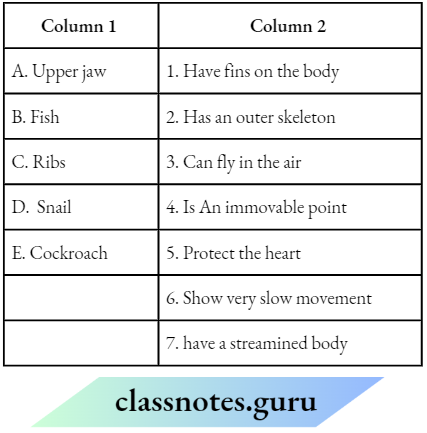
Answer: A-4, B-1 or 7, C-5, D-6 or 2, E-2 or 3
